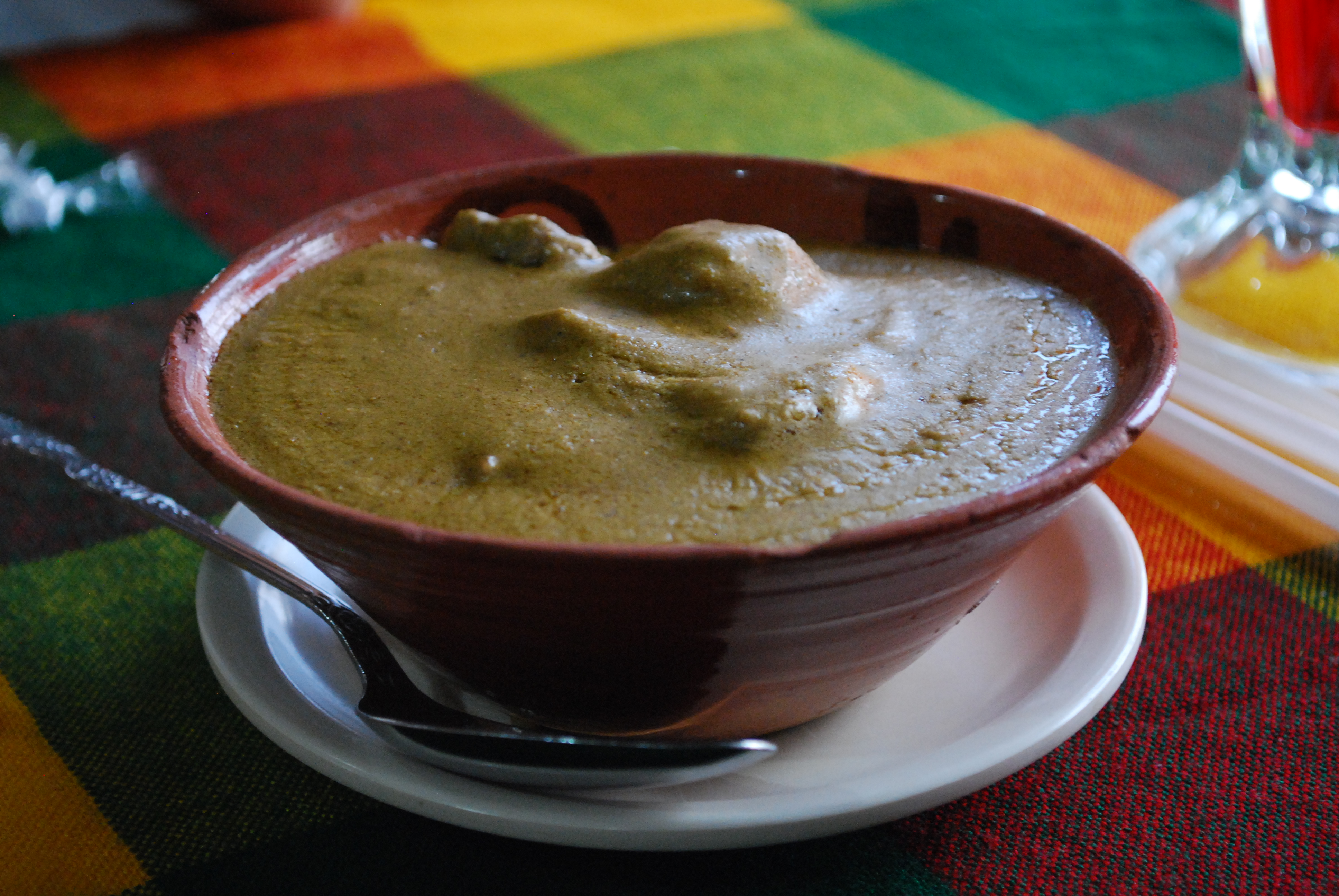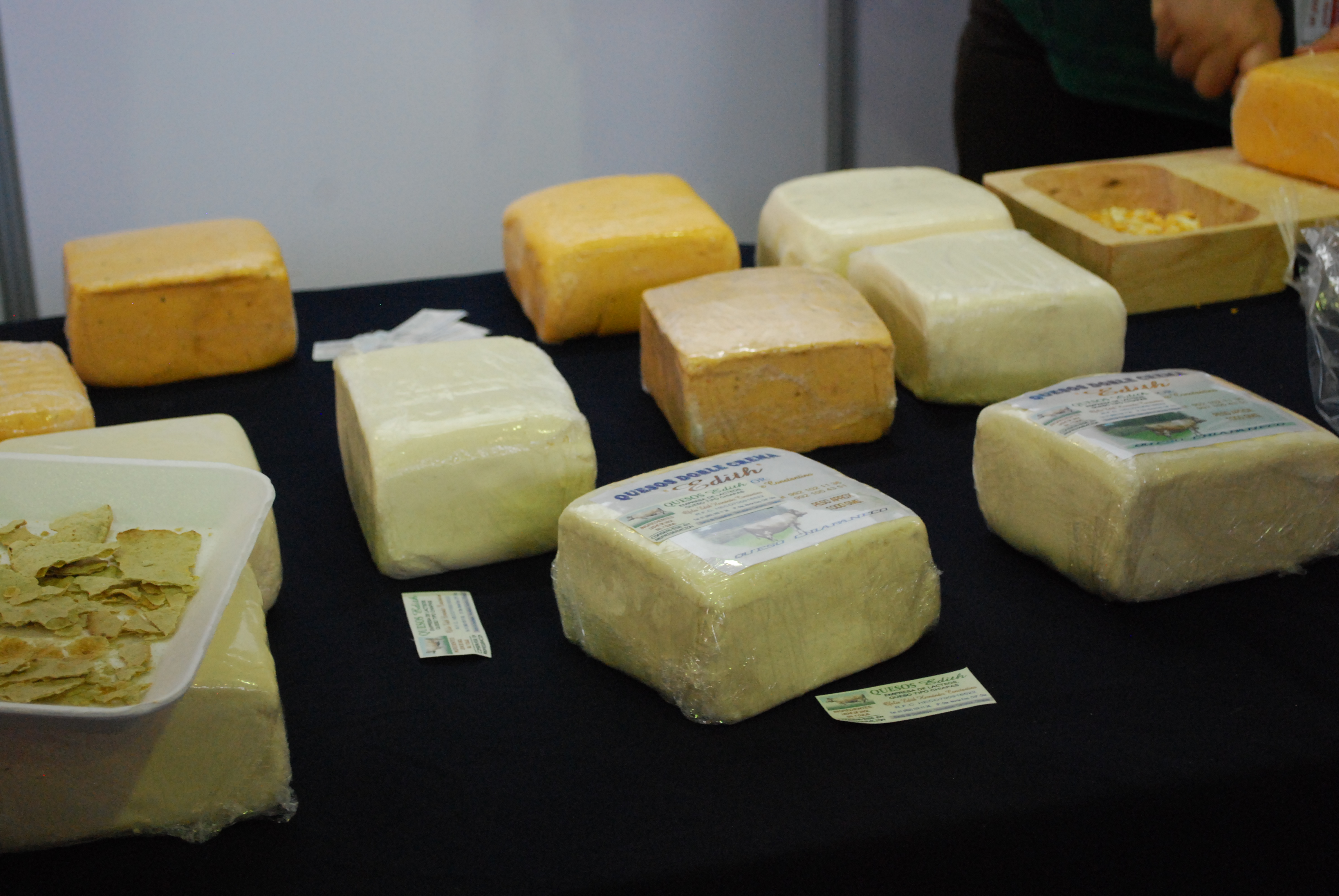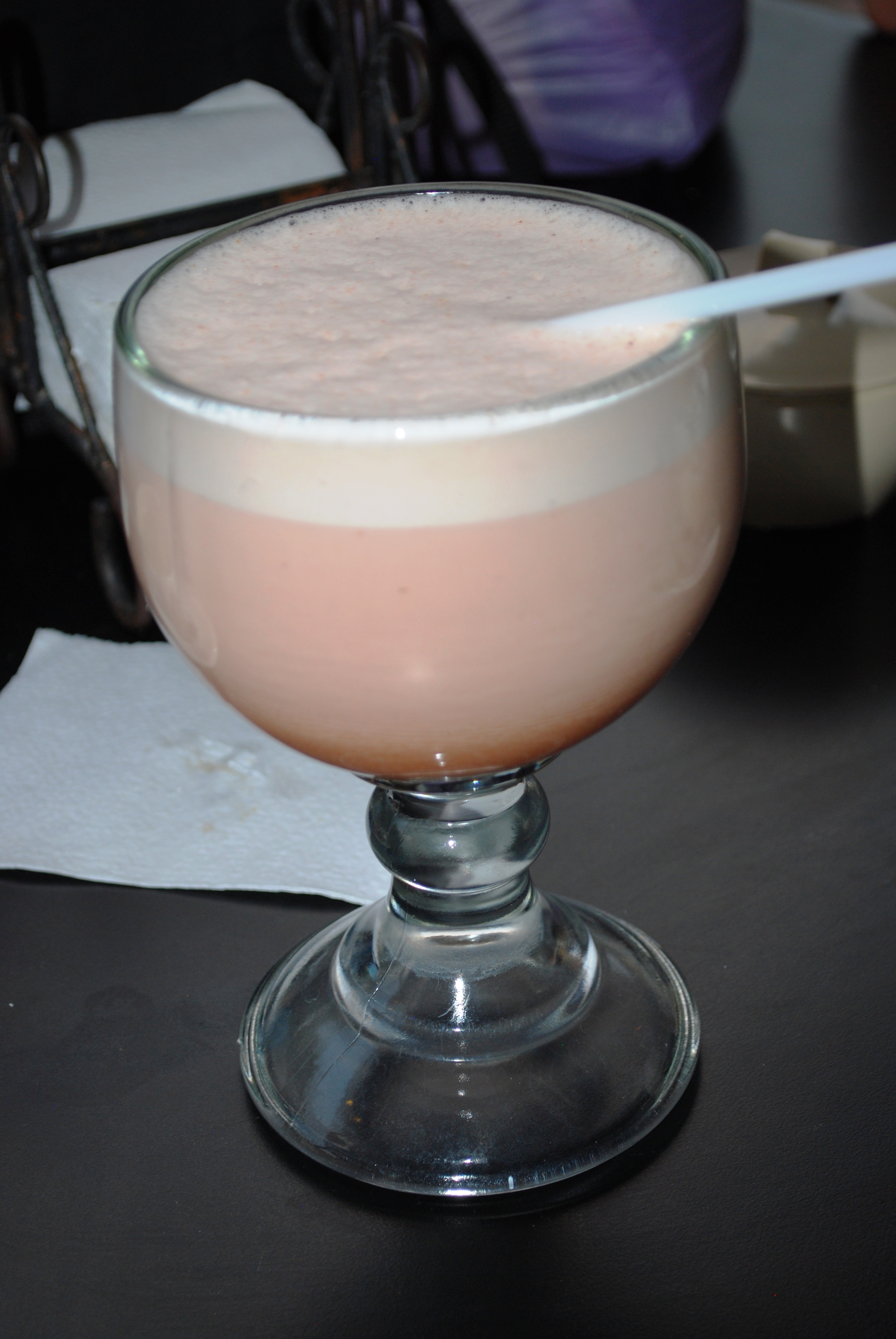Cuisine of Chiapas on:
[Wikipedia]
[Google]
[Amazon]
 The cuisine of Chiapas is a style of cooking centered on the Mexican state of the same name. Like the cuisine of rest of the country, it is based on corn with a mix of indigenous and European influences. It distinguishes itself by retaining most of its indigenous heritage, including the use of the
The cuisine of Chiapas is a style of cooking centered on the Mexican state of the same name. Like the cuisine of rest of the country, it is based on corn with a mix of indigenous and European influences. It distinguishes itself by retaining most of its indigenous heritage, including the use of the
 Like most of the rest of Mexican cooking, the cuisine of Chiapas is mostly a blending of indigenous and Spanish ingredients and cooking techniques. Chiapan cooking is still heavily influenced by the indigenous, especially the use of native herbs such as chipilín, a fragrant, thin leaved plant used most often in tamales and soups and
Like most of the rest of Mexican cooking, the cuisine of Chiapas is mostly a blending of indigenous and Spanish ingredients and cooking techniques. Chiapan cooking is still heavily influenced by the indigenous, especially the use of native herbs such as chipilín, a fragrant, thin leaved plant used most often in tamales and soups and  Since the Spanish conquest, a number of ingredients have been added to the cuisine. Spanish influence is mostly seen with the introduction of meats such as beef, pork and chicken, with beef as the most popular. Much of the terrain is ideal for cattle ranching and since the colonial period, the raising of cattle and sheep has been an important economic activity. One notable beef dish is grilled strips called tasajo which is served with a variety of sauces. The raising of cattle has also spurred a cheese industry, most of which is still made on ranches and small cooperatives. The main cheese making areas are Ocosingo, Rayón and Pijijiapan. Rounds of white cheese from Ocosingo are popular with gourmets in various parts of Mexico. The colder areas of the state make cured meats. Crops which have been introduced include coffee, soybeans, cotton, sugar and a wide variety of exotic tropical fruit.
Since the Spanish conquest, a number of ingredients have been added to the cuisine. Spanish influence is mostly seen with the introduction of meats such as beef, pork and chicken, with beef as the most popular. Much of the terrain is ideal for cattle ranching and since the colonial period, the raising of cattle and sheep has been an important economic activity. One notable beef dish is grilled strips called tasajo which is served with a variety of sauces. The raising of cattle has also spurred a cheese industry, most of which is still made on ranches and small cooperatives. The main cheese making areas are Ocosingo, Rayón and Pijijiapan. Rounds of white cheese from Ocosingo are popular with gourmets in various parts of Mexico. The colder areas of the state make cured meats. Crops which have been introduced include coffee, soybeans, cotton, sugar and a wide variety of exotic tropical fruit.
 Chiapas cuisine does not rely as heavily on chili peppers as the other regional Mexican cuisines. They mostly appear in condiments. Regional chili peppers include the “chile de siete caldos” (chili pepper of the seven broths) indicating that one is sufficient to flavor all seven and the simojovel, which is far too hot to be used in quantity. Chiapan food favors a combination of slightly sweet seasonings in the main dishes, which include tomatoes, cinnamon, plantains, prunes and pineapple. The Chiapas version of chile relleno includes peas, almonds, peaches, dried candied pineapple and raisins.
There have been some foreign influences on the cuisine from the immigration of Germans, English, French and Asians after that of the Spanish. German contributions included the development of a coffee-growing industry as well as the making of beer and cured meats in some areas. Coffee is an important crop in the Soconusco area, much of which is exported and attracts tourism.
Today, popular cultivated crops found in the cuisine include squashes, potatoes,
Chiapas cuisine does not rely as heavily on chili peppers as the other regional Mexican cuisines. They mostly appear in condiments. Regional chili peppers include the “chile de siete caldos” (chili pepper of the seven broths) indicating that one is sufficient to flavor all seven and the simojovel, which is far too hot to be used in quantity. Chiapan food favors a combination of slightly sweet seasonings in the main dishes, which include tomatoes, cinnamon, plantains, prunes and pineapple. The Chiapas version of chile relleno includes peas, almonds, peaches, dried candied pineapple and raisins.
There have been some foreign influences on the cuisine from the immigration of Germans, English, French and Asians after that of the Spanish. German contributions included the development of a coffee-growing industry as well as the making of beer and cured meats in some areas. Coffee is an important crop in the Soconusco area, much of which is exported and attracts tourism.
Today, popular cultivated crops found in the cuisine include squashes, potatoes,
 The most prominent and popular dish in Chiapas is
The most prominent and popular dish in Chiapas is
 Various areas of the state have their own specialties. The state has eighteen recognized indigenous groups, many of which are of Mayan descent. One of the best known of Chiapas’ eighteen indigenous groups are the Lacandones which live in the rainforest of the same name. Most of their dishes are based on corn, which is cooked in kernels (including popped) and as a cooked dough. Their food also features a number of wild mushrooms and a fermented drink called balché . The Zoques in the northwest of the state and central valleys are known for their consumption of a small freshwater snail called chuti. These are generally collected in the spring in streams and ponds. They are most traditionally cooked in a broth flavored with hoja santa, then the broth is thickened with corn dough. The snails are also eaten as a snack or bar food in
Various areas of the state have their own specialties. The state has eighteen recognized indigenous groups, many of which are of Mayan descent. One of the best known of Chiapas’ eighteen indigenous groups are the Lacandones which live in the rainforest of the same name. Most of their dishes are based on corn, which is cooked in kernels (including popped) and as a cooked dough. Their food also features a number of wild mushrooms and a fermented drink called balché . The Zoques in the northwest of the state and central valleys are known for their consumption of a small freshwater snail called chuti. These are generally collected in the spring in streams and ponds. They are most traditionally cooked in a broth flavored with hoja santa, then the broth is thickened with corn dough. The snails are also eaten as a snack or bar food in  The cool highlands share the affinity for cured meats, including the city of Comitán . The city is also known for pit barbecued chicken, a salad of hearts of palm in vinaigrette and cheese. They also produce a drink called comiteco, which is fermented from maguey and a drink called mistela, made from fruits such as mango,
The cool highlands share the affinity for cured meats, including the city of Comitán . The city is also known for pit barbecued chicken, a salad of hearts of palm in vinaigrette and cheese. They also produce a drink called comiteco, which is fermented from maguey and a drink called mistela, made from fruits such as mango,
 The cuisine of Chiapas is a style of cooking centered on the Mexican state of the same name. Like the cuisine of rest of the country, it is based on corn with a mix of indigenous and European influences. It distinguishes itself by retaining most of its indigenous heritage, including the use of the
The cuisine of Chiapas is a style of cooking centered on the Mexican state of the same name. Like the cuisine of rest of the country, it is based on corn with a mix of indigenous and European influences. It distinguishes itself by retaining most of its indigenous heritage, including the use of the chipilín
''Crotalaria longirostrata'', the chipilín, is a perennial legume that is native to Mexico and Central America. Other common names include chepil, chepilin, chipilin and longbeak rattlebox.
Description
Chipilín leaves are a common leafy vegeta ...
herb in tamales and soups, used nowhere else in Mexico
Mexico (Spanish: México), officially the United Mexican States, is a country in the southern portion of North America. It is bordered to the north by the United States; to the south and west by the Pacific Ocean; to the southeast by Guatema ...
. However, while it does use some chili pepper
Chili peppers (also chile, chile pepper, chilli pepper, or chilli), from Nahuatl '' chīlli'' (), are varieties of the berry-fruit of plants from the genus ''Capsicum'', which are members of the nightshade family Solanaceae, cultivated for ...
s, including the very hot simojovel, it does not use it as much as other Mexican regional cuisines, preferring slightly sweet seasoning to its main dishes. Large regions of the state are suitable for grazing and the cuisine reflects this with meat, especially beef and the production of cheese
Cheese is a dairy product produced in wide ranges of flavors, textures, and forms by coagulation of the milk protein casein. It comprises proteins and fat from milk, usually the milk of cows, buffalo, goats, or sheep. During production, ...
. The most important dish is the tamal
A tamale, in Spanish tamal, is a traditional Mesoamerican dish made of masa, a dough made from nixtamalized corn, which is steamed in a corn husk or banana leaf. The wrapping can either be discarded prior to eating or used as a plate. Tamales ...
, with many varieties created through the state as well as dishes such as chanfaina, similar to menudo and sopa de pan. Although it has been promoted by the state of Chiapas for tourism purposes as well as some chefs, it is not as well known as other Mexican cuisine, such as that of neighboring Oaxaca
Oaxaca ( , also , , from nci, Huāxyacac ), officially the Free and Sovereign State of Oaxaca ( es, Estado Libre y Soberano de Oaxaca), is one of the 32 states that compose the political divisions of Mexico, Federative Entities of Mexico. It is ...
.
Ingredients
hoja santa
''Piper auritum'' is an aromatic culinary herb in the pepper family Piperaceae, which grows in tropical Central America. Common names include hoja santa (Spanish for "sacred leaf"), yerba santa, hierba santa, Mexican pepperleaf, acuyo, tlanepa, a ...
, which is used in much of southern Mexican cooking. The cuisine is based on the Mesoamerica
Mesoamerica is a historical region and cultural area in southern North America and most of Central America. It extends from approximately central Mexico through Belize, Guatemala, El Salvador, Honduras, Nicaragua, and northern Costa Rica. W ...
n staple of corn, most often found in tortilla
A tortilla (, ) is a thin, circular unleavened flatbread originally made from maize hominy meal, and now also from wheat flour. The Aztecs and other Nahuatl speakers called tortillas ''tlaxcalli'' (). First made by the indigenous peoples of Me ...
s and tamales, but also in a number of preparations including drinks. Other indigenous ingredients include chili peppers, cacao beans
Cacao is the seed from which cocoa and chocolate are made, from Spanish cacao, an adaptation of Nahuatl cacaua, the root form of cacahuatl ("bean of the cocoa-tree"). It may also refer to:
Plants
*''Theobroma cacao'', a tropical evergreen tree
** ...
, beans, avocado
The avocado (''Persea americana'') is a medium-sized, evergreen tree in the laurel family (Lauraceae). It is native to the Americas and was first domesticated by Mesoamerican tribes more than 5,000 years ago. Then as now it was prized for i ...
s and an edible flower called “cuchunuc” . A number of wild plants are still eaten including radishes, mustard, sour tomatoes and a variety of mushrooms. Cacaoite, is a seed which is ground to along with those of squash and to make sauces. In rural areas, meats such as armadillo
Armadillos (meaning "little armored ones" in Spanish) are New World placental mammals in the order Cingulata. The Chlamyphoridae and Dasypodidae are the only surviving families in the order, which is part of the superorder Xenarthra, along wi ...
, tepezcuintle, iguana
''Iguana'' (, ) is a genus of herbivorous lizards that are native to tropical areas of Mexico, Central America, South America, and the Caribbean. The genus was first described in 1768 by Austrian naturalist Josephus Nicolaus Laurenti in his bo ...
, wild boar, rabbit, and various native birds are still eaten. Chiapas cuisine favors black beans, although some areas such as San Juan Chamula
San Juan Chamula is a ''municipio'' (municipality) and township in the Mexican state of Chiapas. It is situated some from San Cristóbal de las Casas.
As of 2010, the municipality had a total population of 76,941. Virtually the entire popula ...
consume a variety. Beans are generally prepared simply just with salt and chili pepper, generally without fat.
fava bean
''Vicia faba'', commonly known as the broad bean, fava bean, or faba bean, is a species of vetch, a flowering plant in the pea and bean family Fabaceae. It is widely cultivated as a crop for human consumption, and also as a cover crop. Variet ...
s, chayote, cabbage, cucumbers, sweet potatoes, yucca, various melons, watermelon, mango, papaya
The papaya (, ), papaw, () or pawpaw () is the plant species ''Carica papaya'', one of the 21 accepted species in the genus ''Carica'' of the family Caricaceae. It was first domesticated in Mesoamerica, within modern-day southern Mexico and ...
, sapodilla
''Manilkara zapota'', commonly known as sapodilla (), sapote, naseberry, nispero or chicle, is a long-lived, evergreen tree native to southern Mexico, Central America and the Caribbean. An example natural occurrence is in coastal Yucatán in the ...
, soursop
Soursop (also called ''graviola, guyabano'', and in Hispanic America, ''guanábana'') is the fruit of ''Annona muricata'', a broadleaf, flowering, evergreen tree. It is native to the tropical regions of the Americas and the Caribbean and is wid ...
, cherimoya
The cherimoya (''Annona cherimola''), also spelled chirimoya and called chirimuya by the Inca people, is a species of edible fruit-bearing plant in the genus '' Annona'', from the family Annonaceae, which includes the closely related sweetsop a ...
, mamey sapote, pitahaya
A pitaya () or pitahaya () is the fruit of several different cactus species indigenous to the Americas. Pitaya usually refers to fruit of the genus ''Stenocereus'', while pitahaya or dragon fruit refers to fruit of the genus '' Selenicereus'' ...
, cupapé (''Cordia dodecandra'').
Popular dishes
 The most prominent and popular dish in Chiapas is
The most prominent and popular dish in Chiapas is tamale
A tamale, in Spanish tamal, is a traditional Mesoamerican dish made of masa, a dough made from nixtamalized corn, which is steamed in a corn husk or banana leaf. The wrapping can either be discarded prior to eating or used as a plate. Tamale ...
s, found in many varieties. Chiapas’s main herbs of chipilín and hoja santa can be found in many of these. Most varieties are wrapped in banana leaves, but they can also be found wrapped in corn husks and even in the leaves of hoja santa. Important varieties include jacuané (local name for hoja santa), de bola (pork in a chirmol chili pepper sauce), turtle, iguana and fish. Another dish found in a number of varieties is chanfaina, which is a tripe stew similar to menudo. Sopa de pan (bread soup) is a flavored chicken broth which dried and fried pieces of bread is added at the last minute before eating. In Chiapas, it is popular for special occasions. Other dishes include huevos de vigilia, rollitos de plátano, fideo fiestero, pit barbecued beef, sea bass in its own juice, rice with saffron
Saffron () is a spice derived from the flower of ''Crocus sativus'', commonly known as the "saffron crocus". The vivid crimson stigma and styles, called threads, are collected and dried for use mainly as a seasoning and colouring agent i ...
, frijol escumite con chilpilin, black beans with salted beef, tanate, chumul, caldo de shuti, armadillo stew, nacapitu, cuchunuc, putzatzé, yumimujé, broths flavored with chipilin, fresh corn and meat with vegetables.
Regional drinks include pozol
Pozol (from the Nahuatl ) is the name of both fermented corn dough and the cocoa drink made from it, which has its origins in Pre-Columbian Mexico. The drink is consumed in the south of Mexico in the states of Chiapas and Tabasco. It is a thi ...
in various preparations (reventado, negro, blanco, cacao and more), sweet drinks made with fruit, tamarind and more, tascalate, atole
''Atole'' (, from Nahuatl '' ātōlli'' ), also known as ''atolli'' and ''atol de elote'', is a traditional hot corn- and masa-based beverage of Mexican origin. Chocolate ''atole'' is known as ''champurrado'' or ''atole''. It typically accomp ...
and hot chocolate. The main alcoholic beverages are those made from sugar cane. These include various prepared from fermented sugarcane as well as the distilled aguardiente
(Spanish), or (Portuguese) ( eu, pattar; ca, aiguardent; gl, augardente), is a generic term for alcoholic beverages that contain between 29% and 60% alcohol by volume (ABV). It originates in the Iberian Peninsula (Portugal and Spain) and in I ...
, which is also used to conserve fruit.
Regional specialties
Tuxtla Gutierrez Tuxtla may refer to:
;Cities and towns
*Tuxtla Gutiérrez, capital of the Mexican state of Chiapas
*San Andrés Tuxtla, Veracruz
*Santiago Tuxtla, Veracruz
*Tuxtla Chico, Chiapas
;Other
*Los Tuxtlas, region of Veracruz
*Sierra de los Tuxtlas, moun ...
. Another exotic food from this area is the bee larvae.
The cultural center of the state is San Cristobal de las Casas. Specialties in this city are based mostly on cured meats such as ham and sausages, which are of Spanish origin attributed to Bartolomé de las Casas, as well as indigenous dishes such as various tamales (including one flavored with saffron) . A common street food in San Cristobal is called a cazueleja, which is a roll stuffed with cheese, egg and cinnamon. San Cristobal is also known for its sweets as it is common to consume these with coffee in the late evenings. Sweets include crystallized fruit, coconut candies, a caramel spread called cajeta and various sweet and normal breads, which were introduced to the area by the French.
The major population center of the state is the capital of Tuxtla Gutiérrez with Chiapa de Corzo across the river. Local specialties here include ningüijute, a seed-based pork mole
Mole (or Molé) may refer to:
Animals
* Mole (animal) or "true mole", mammals in the family Talpidae, found in Eurasia and North America
* Golden moles, southern African mammals in the family Chrysochloridae, similar to but unrelated to Talpida ...
, chispola, a beef and vegetable stew and pictes, a sweet corn tamale. Chiapa de Corzo is also known for cochito horneado or a suckling pig roasted with adobo seasoning for special occasions.
 The cool highlands share the affinity for cured meats, including the city of Comitán . The city is also known for pit barbecued chicken, a salad of hearts of palm in vinaigrette and cheese. They also produce a drink called comiteco, which is fermented from maguey and a drink called mistela, made from fruits such as mango,
The cool highlands share the affinity for cured meats, including the city of Comitán . The city is also known for pit barbecued chicken, a salad of hearts of palm in vinaigrette and cheese. They also produce a drink called comiteco, which is fermented from maguey and a drink called mistela, made from fruits such as mango, tejocote
''Crataegus mexicana'' is a species of hawthorn known by the common names , , and Mexican hawthorn. It is native to the mountains of Mexico and parts of Guatemala, and has been introduced in the Andes. The fruit of this species is one of the mos ...
and plum.
The coastline, which is separated from the inland by a line of mountains, make use of Pacific coast seafood in its cuisine, including bass, grouper, mojarra, sardines, shrimp, crabs and clams. Shrimp is often dried for later consumption. These shrimp are often combined with tomato salsa for an appetizer or used with black beans and pumpkin seeds as a filling for tamales juacanes.
Palenque is a cattle raising area with good beef dishes as many versions of fried plantains, including ones filled with black beans or cheese.
The commercial agriculture of the Soconusco has attracted immigrants with restaurants serving Chinese, Japanese and German food found in the area. The most notable food in Tapachula is Chinese style, from immigration of Chinese into the area in the late 19th and early 20th centuries.
Promotion of the cuisine
Most Chiapas cooking is humble peasant food and is not as sophisticated or complicated as the neighboring Oaxacan cuisine. The cuisine of the state is not that well known, being less documented than that ofOaxaca
Oaxaca ( , also , , from nci, Huāxyacac ), officially the Free and Sovereign State of Oaxaca ( es, Estado Libre y Soberano de Oaxaca), is one of the 32 states that compose the political divisions of Mexico, Federative Entities of Mexico. It is ...
, Puebla
Puebla ( en, colony, settlement), officially Free and Sovereign State of Puebla ( es, Estado Libre y Soberano de Puebla), is one of the 32 states which comprise the Federal Entities of Mexico. It is divided into 217 municipalities and its cap ...
or Michoacán
Michoacán, formally Michoacán de Ocampo (; Purépecha: ), officially the Free and Sovereign State of Michoacán de Ocampo ( es, Estado Libre y Soberano de Michoacán de Ocampo), is one of the 32 states which comprise the Federal Entities of ...
.
Nonetheless, the cuisine has been promoted internationally by chefs such as Rick Bayless and Erwin Ramos . Starting in the 1990s, the state of Chiapas began to promote the cuisine through events, media and professional culinary associations such as the Corporation Mexicana de Restaurantes. The state also declared the cuisine an intangible heritage and a source of sustainable tourism
Sustainable tourism is a concept that covers the complete tourism experience, including concern for economic, social and environmental issues as well as attention to improving tourists' experiences and addressing the needs of host communities. Su ...
. It has sponsored culinary festivals such as the Festival de al Autentica Cocina Chiapaneca and culinary competitions for professional chefs using traditional ingredients. One of these is the Alta Cocina Regional y de Author de Chiapas, founded by chef Marta Zepeda of the Tierra y Cielo Hotel in San Cristobal.
References
{{Portal bar, Mexico, Food Chiapas Mexican cuisine